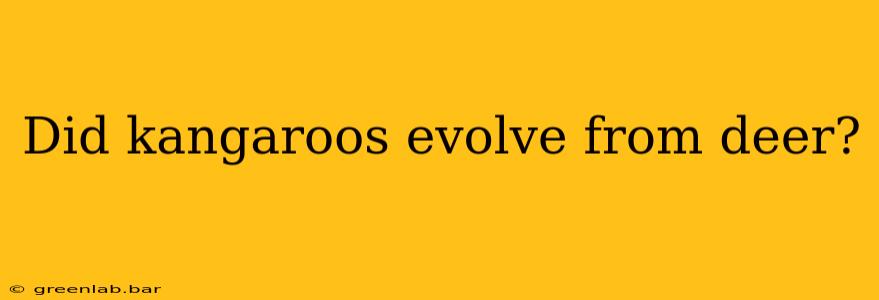The question of whether kangaroos evolved from deer is a common misconception stemming from superficial similarities in their herbivorous diets and, to some extent, their leaping locomotion. However, the evolutionary paths of kangaroos and deer diverged millions of years ago, placing them in entirely different branches of the mammalian family tree. This article will explore the evolutionary history of both kangaroos and deer, clarifying their distinct lineages and highlighting the key differences that set them apart.
The Evolutionary Journey of Kangaroos: A Marsupial Story
Kangaroos belong to the order Diprotodontia, a group of marsupials characterized by two large lower incisors. Marsupials, unlike placental mammals (which include deer), are known for their unique reproductive strategy: the young are born at a relatively undeveloped stage and complete their development in a pouch. This characteristic distinguishes marsupials from placental mammals early in their evolutionary history.
Key Evolutionary Milestones:
- Early Marsupial Divergence: The earliest marsupial ancestors emerged in the Mesozoic Era, likely in the Americas, long before the diversification of placental mammals.
- Gondwanan Origins: The supercontinent Gondwana played a crucial role in marsupial evolution. As Gondwana broke apart, marsupials spread to Australia, South America, and Antarctica, undergoing significant adaptive radiation.
- Australian Radiation: In Australia, the absence of many placental mammal groups allowed marsupials to fill a wide range of ecological niches, leading to the evolution of diverse forms, including kangaroos, wallabies, koalas, and wombats.
- Kangaroo Specialization: Kangaroos specifically evolved their hopping locomotion, powerful hind legs, and specialized digestive systems adapted to a herbivorous diet over millions of years.
The Evolutionary Lineage of Deer: Placental Mammal Success
Deer, on the other hand, are placental mammals belonging to the order Artiodactyla, which includes even-toed ungulates such as cows, sheep, and pigs. Placental mammals have a much longer gestational period, with the young developing extensively within the mother's uterus before birth.
Key Evolutionary Milestones:
- Early Artiodactyl Divergence: The ancestors of artiodactyls emerged in the Eocene epoch, diversifying and adapting to various environments.
- Ruminant Evolution: Deer are ruminants, meaning they have a specialized four-chambered stomach allowing them to efficiently digest plant matter. This adaptation contributed significantly to their evolutionary success.
- Antler Development: The evolution of antlers, primarily found in male deer, is a notable feature, playing a vital role in mate competition and intraspecific displays.
- Global Distribution: Deer have achieved a wide geographical distribution, inhabiting various habitats across the globe.
Clear Evolutionary Divergence: Why Kangaroos Aren't Related to Deer
The fundamental difference lies in their reproductive strategies (marsupial vs. placental) and their deep evolutionary history. Molecular phylogenetic studies, analyzing genetic data, conclusively demonstrate that kangaroos and deer are extremely distantly related, belonging to separate mammalian lineages that diverged very early in mammalian evolution. The similarities in their herbivorous diets and leaping ability are examples of convergent evolution—the independent evolution of similar traits in unrelated species due to similar environmental pressures.
Conclusion: Convergent Evolution, Not Common Ancestry
The similarities between kangaroos and deer are superficial and result from convergent evolution, not common ancestry. Their distinct reproductive strategies, genetic makeup, and evolutionary histories clearly establish them as separate branches on the vast mammalian family tree. The notion that kangaroos evolved from deer is fundamentally incorrect.

